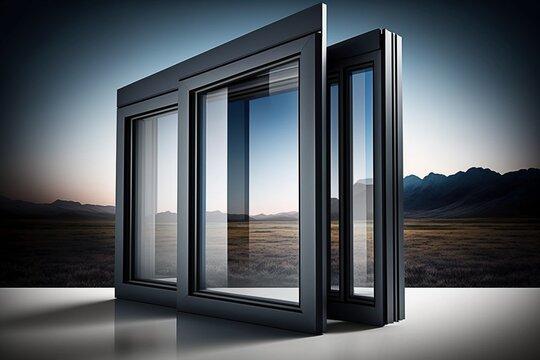Aluminium Windows Market Strengthens as Architects Favor Durable and Recyclable Building Materials

The aluminium windows market is poised for steady growth in the long term, fueled by rising urbanization, increasing construction activity, and a growing demand for sustainable, durable building materials. With aluminium's superior strength-to-weight ratio, corrosion resistance, and recyclability, it is becoming a material of choice for modern architecture. As global trends in smart cities, green buildings, and energy-efficient infrastructure gain momentum, aluminium windows are well-positioned to benefit.
Market Drivers
One of the primary drivers of the aluminium windows market is the rapid pace of urban development. Emerging economies, particularly in Asia-Pacific and Africa, are experiencing large-scale urban migration, leading to an increased demand for residential and commercial buildings. Aluminium windows, known for their sleek aesthetics and structural stability, are increasingly being specified in architectural designs that prioritize modernity and minimalism.
Energy efficiency is another key growth factor. Aluminium frames can now be thermally broken, allowing them to meet stringent energy codes. When combined with double or triple-glazing technologies, they offer excellent insulation. Governments around the world are tightening building regulations, pushing for higher energy performance. As a result, property developers and homeowners are turning toward high-performance aluminium windows to achieve compliance and reduce long-term energy costs.
Sustainability and Recycling
Aluminium is one of the most sustainable construction materials. It can be recycled repeatedly without losing its properties, and recycling aluminium uses only about 5% of the energy required for primary production. As sustainability becomes central to procurement decisions in construction, the environmental advantages of aluminium windows are being more widely recognized.
Certifications such as LEED (Leadership in Energy and Environmental Design) and BREEAM (Building Research Establishment Environmental Assessment Method) often reward the use of recyclable and energy-efficient materials, further driving demand. In Europe, where sustainability in construction is highly prioritized, aluminium windows have already seen increasing adoption in retrofitting and green building projects.
Innovations and Product Developments
Technology and design innovations are enhancing the performance and aesthetics of aluminium windows. Manufacturers are introducing slimmer profiles that maximize natural light while maintaining structural integrity. There is also a shift toward customized solutions, allowing architects and builders greater flexibility in design.
Smart window technologies are being integrated into aluminium frames, offering features such as automated opening systems, remote control via smartphones, and electrochromic glass that adjusts its tint in response to sunlight. These advancements align well with smart home trends and increase the appeal of aluminium windows in premium segments.
In terms of coatings and finishes, powder coating and anodizing processes have improved significantly, offering greater color variety, UV resistance, and longer lifespan. This has opened up more design possibilities and enhanced the visual appeal of aluminium windows in both residential and commercial sectors.
Regional Outlook
Asia-Pacific is expected to remain the largest and fastest-growing market, driven by China, India, and Southeast Asia. Massive infrastructure initiatives, expanding middle classes, and a boom in real estate development support sustained demand. Government-backed housing schemes and smart city projects will further accelerate growth.
Europe continues to be a mature but steadily growing market, thanks to its strong emphasis on energy efficiency and sustainability. Retrofitting of old buildings and adherence to strict energy regulations are key contributors.
North America shows moderate growth, with demand bolstered by both residential remodeling and commercial projects. Innovations in smart windows and energy-saving technologies are likely to fuel the adoption of aluminium windows in premium markets.
Middle East and Africa present untapped potential, especially in urban centers with ongoing high-rise development. Aluminium’s heat resistance and durability make it suitable for harsh climates, giving it an edge over other materials.
Challenges and Considerations
Despite its many advantages, the aluminium windows market faces certain challenges. The production of primary aluminium is energy-intensive and can contribute to greenhouse gas emissions unless sourced responsibly. This has raised concerns in some environmental circles. However, the industry's growing shift toward using recycled aluminium and sourcing clean energy is helping to mitigate this issue.
Another consideration is cost. Aluminium windows can be more expensive than alternatives like uPVC, especially in markets where aluminium isn’t readily available or where energy costs for production are high. However, the long-term benefits — durability, low maintenance, and energy savings — often outweigh the upfront costs.
Conclusion
The long-term outlook for the aluminium windows market is decidedly positive. With robust demand driven by urbanization, sustainability goals, and architectural innovation, the market is likely to see consistent growth across regions. Continued investment in energy-efficient technologies, recycling infrastructure, and smart features will enhance aluminium’s appeal as a material of the future. As the construction industry evolves toward smarter, greener practices, aluminium windows will remain a vital component in building tomorrow’s cities.
- Art
- Causes
- Crafts
- Dance
- Drinks
- Film
- Fitness
- Food
- Games
- Gardening
- Health
- Home
- Literature
- Music
- Networking
- Other
- Party
- Religion
- Shopping
- Sports
- Theater
- Wellness


